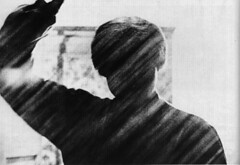 Having covered free speech and media policy issues for many years now, one of the arguments I hear a lot is that we moderns have an unnatural fascination with murder, mayhem, and violence as well as gossip and celebrities. Social critics and proponents of media content regulation often wax nostalgic about the supposed "good ol' days" when all we thought and talked about was enlightened and enriching topics.
Having covered free speech and media policy issues for many years now, one of the arguments I hear a lot is that we moderns have an unnatural fascination with murder, mayhem, and violence as well as gossip and celebrities. Social critics and proponents of media content regulation often wax nostalgic about the supposed "good ol' days" when all we thought and talked about was enlightened and enriching topics.
It's all complete nonsense. Anyone who has seriously studied our nation's history -- or, for that matter, the history of any country or civilization -- knows that we humans have always been fascinated by the morbid and tales of debauchery, especially when those tales involve public officials or celebrities.
I was reminded of this again today when reading two articles in the Washington Post.
One was an article by Shankar Vedantam, who pens the the always entertaining "Department of Human Behavior" column for the Post. His column today is entitled, "Why Fluff-Over-Substance Makes Perfect Evolutionary Sense." He asks:
Why are we more likely to discuss a gossipy rumor at a party than a policy error that can actually make a material difference to our own lives? One explanation is that cultural mores attune us to certain stories -- we live in an era where gossipy scandals rule. To test this, psychologist Hank Davis at the University of Guelph in Ontario examined hundreds of sensational stories on the front pages of newspapers in eight countries over a 300-year period, from 1701 to 2001.Remarkably, he concluded that the themes of sensational news were identical not only across the centuries but also in diverse geographic locales -- from the United States to Bangladesh, from Canada to Mauritius. The stories that editors put on the front pages of newspapers -- presumably stories that interested readers -- included headlines such as "Crocodiles Tear Apart Thai Suicide Woman."
The stories were sometimes about important things and sometimes not, but they nearly always involved the kind of themes that people who are part of small groups like to know about one another: lying and cheating, altruism and heroism, loyalty and disloyalty.
Again, the more things change, the more they stay the same. For whatever reason, we humans have always been fascinated by the dishing of dirt.
Similarly, humans have always been interested in tales of murder and mayhem. A second Post article today reminds us of that. It's a book review by Patrick Anderson of a new collection of essays on crime and murder: True Crime: An American Anthology, edited by Harold Schechter.
I've written about Schechter's work before, especially his brilliant Savage Pastimes: A Cultural History of Violent Entertainment.
In that book, Schechter meticulously documents the prevalence of violent fare throughout the history of art and entertainment. He notes that even "the supposedly halcyon days of the 1950s" were replete with violent fare, much of it aimed at children. "[T]he fact is that -- contrary to popular belief -- there was a shockingly high level of sadistic violence and gore in some of the most popular commercial entertainments of the 1950s." Mickey Spillane's best-selling "Mike Hammer" novels were a prime example. "Even the most vehement critics of contemporary popular culture would be hard-pressed to find anything in today's mainstream mass entertainment as alarming as the gore-drenched, gun-worshipping fantasies that Spillane and his publisher dished out for the delectation of millions of ordinary American readers in the supposedly halcyon days of the 1950s," argues Schechter. He also recounts the extraordinary gore of "pulp" comics during that decade, which were often replete with macabre, masochistic scenes. Schechter also notes the top-rated television program of 1954, Disney's Davy Crockett series, "contained a staggering amount of graphic violence,"including scalpings, stabbings, "brainings," hatchet and tomahawk blows, and so on. The series finale takes place at the Alamo and contained, in Schechter's opinion, a "level of carnage [that] remains unsurpassed in the history of televised children's entertainment." (Incidentally, the show aired Wednesday nights at 7:30 to target the elementary school crowd!)
Anyway, I have not yet had the opportunity to read Schechter's new collection of True Crime essays, but Patrick Anderson's review confirms the general thesis I have set forth here. He points out how many of the essays in Schechter's compendium were written by revered American authors, and they are just as engrossing today as they were decades ago:
The anthology's 50 nonfiction pieces, most originally published in newspapers and magazines, include some by authors as celebrated as Mark Twain, Nathaniel Hawthorne, James Thurber, Theodore Dreiser and Truman Capote. [and...] The New Yorker's Annals of Crime series has employed the talents of Alexander Woollcott, James Thurber, A.J. Liebling and Calvin Trillin; their articles collected here include Liebling's classic "Case of the Scattered Dutchman," which concerns body parts found floating in the East River.The anthology is almost obscenely entertaining, if one has a strong stomach and a certain mind-set, but it is also a searching look at the dark underside of American reality, at an aspect of the human condition that both horrifies and fascinates us."
Anderson really nails it there. There truly is "an aspect of the human condition" that leads us to remain interested in this stuff. It's always been with us and always will with us. It's silly for media critics and would-be censors to suggest otherwise.